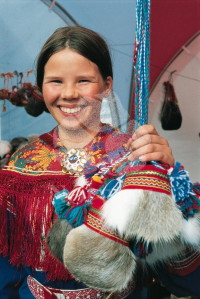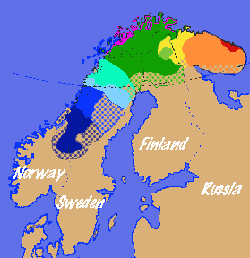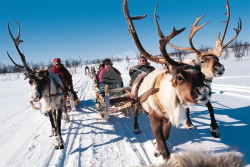
Saemieh, the reindeer
people
The Sámi are an indigenous
colourful people who form an ethnic minority in Norway,
Sweden and
Finland.
There is also a small population on Russia's
Kola peninsula. The Sami's language, traditional clothing, handicraft, and music,
are distinctively different from other ethnic groups in Scandinavia.
Photo. A young Sami girl is smiling, Hammerfest, Norway.
She is holding Sami shoes (photo
number 062000-99#107, photographer Kurt Hamann/NTR - www.ntr.no).
In more recent
history, from about the sixteenth century, Sámi have inhabited nearly all the
areas of the Nordic countries where they now have permanent settlements. The
Sámi region extends from Idre, in Dalarne,
Sweden, and
adjacent areas in Norway south
to Engerdal in Hedmark
County. To the
north and east it stretches to Utsjoki in
Finland,
Varanger in Norway and
on to the Kola
peninsula in
Russia.
The size of the
Sámi population is estimated to be between 60,000 and 100,000; a cautious
estimate would be about 70,000. In Norway there
are believed to be between 40,000 and 45,000 Sámi, largely concentrated in
Finnmark, where there are some 25,000.
Sweden has
about 17,000 Sámi,
Finland
around 5,700 and Russia
approximately 2,000.
| Photo (image). Map over areas where the colourful and
nice Sami people the live. |
 |
Theories
It`s believed by
many scientists that long before the Swedish, Finnish or even the Viking culture
had developed, the Scandinavian areas became populated by the Samis (also
written and pronounced Saemieh). They represent one of the oldest living
cultures in Norway, and
possibly the world is that of the Sámi people. The Sami have survived in the
barren landscapes of Sámi
Land (the area
commonly known as Lapland) for thousands of years.
Some traces suggest as long as 4,000 years.
Some scientists
believed that the Sami became mixed with Germanic tribes years ago, and that
the Vikings are descendants of the Sami.
Some other
scientists believe that the Sámi and Vikings are to separate groups, have
different origins, and settled permanently in northern Scandinavia at different time.
Even they who believe that they both came from
Russia believe that the Sami and the Vikings came from
different places and different time.
Based on a legend the famous adventurer and
scientist Thor Heyerdahl believed that the most superior Norse, Viking
God, called Odin, could be a great Viking king the past too. This
Viking God had two ravens, Hugin, meaning thought and
Munin, meaning memory
,
which flew all over the world every day.
In the evening, they sat on his shoulders and whispered in his ears what
they had seen and heard, and kept the supreme god updated. Could this explain
why the Vikings had such huge knowledge about the word at that time?
In
2001 Thor Heyerdal started search for Odin. He has also wrote a book about
his theory. Heyerdahl based his theory on ancient Icelandic texts. He believed that Odin
may have been a real king in the 1st Century BC in what is now southern
Russia, before his tribe was driven out by the Romans. Therefore he funded a major
archaeological dig near the Sea of
Azov, to find traces
after Odin and his tribe.
Someone also believes that the Vikings were the first indigenous
people in Norway, but
this is a theory that it's not broadening supported.
It's said that
the Sámi people have always lived peacefully and never been involved in any war.
As known from the history from ca. 800 to 1050, the Vikings settled down in
Norway and
surrounding northern areas. This group came probably from the east and was not
descending from the Sámi people as some scientists believe. Contrary to the Sámi
the Vikings where fearful warriors. But it`s common believed that the Sami and
Vikings have been trading partners in the past.
Lifestyle and culture of
the Sami
Over half of their current population live in
the part of Sámi Land that falls into Norway, the region called Finnmarksvidda,
though the area covers the northern extremes of Sweden, Finland, and as far east
as Russia.
|
Photo. Sami people on sledge dragged by
reindeers - Finnmarksvidda - mountain plateau - tundra (number 042000-6#9, photographer Mimsy Møller/Samfoto/NTR- www.ntr.no. |
 |
The name "Lapp"
means piece of cloth or patch, and is considered an outdated, and
often derogative term. The name "Sámi" derives from their own name. Therefore it is
a more acceptable term, and is their own preferred name. The "Lapp" name
indicates that the Sámi are wearing patched clothes, a derogatory term and one
that needs to be replaced. The word "Laplander" is also problematic since that
could mean any person who lives within this region, also those that are non
native. Finally there's a part of the Sámi population who always have lived
outside the region of "Lapland".
As the Sámi always
have done, they live today of fishing and hunting. In more recent years they
have based their subsistence more on herding reindeer. The Sámi are a nomadic
people, and in the summer months many still live in their tepee ("tents") like
homes, known as Katas (Gamme), which are easy to move form one place to another.
Time will show what we will find out.
Legends give us inspirations for more explorations about the world and the many mysteries.
Maybe one day we get the complete picture of our own origin and life.
Stein Morten Lund,
3 April
2004
Additional
information
Experience the
Sami's unique lifestyle and culture. Then you should go to Kautokeino, which is
the cultural capital of the Sámi people, right in the heart of Sámi
Norway. It's
also one of the oldest settlements in
Norway,
dating back about 5000 years. Here you can visit the open air museum, depicting
details of traditional Sámi life, which also has an indoor section displaying
traditional Sámi handicrafts.
Language and
culture of the Samis:
There are 9 Sami
languages spoken from Norway to
Russia,
although depending on the country where they live, they can speak Finnish,
Norwegian, Swedish or Russian.
The most spoken
of the Sami languages counts with some 30,000 speakers. The rest of the Sami
languages count in general with less than 500 speakers. The Sámi languages
belong to the Finno-Ugric family and share the same origin than Finnish,
Estonian and Hungarian.
The Sámi language has some 400 words for
reindeer, and one Sámi word has become known worldwide:
Tundra.
The Sámi religious belief is animistic, believing that
everything in nature from animals to minerals have a soul.
Theory and
ancient traces from the Vikings:
The legendary
Norwegian adventurer and scientist, Thor Heyerdahl's theory about the Vikings
origin is based on stories from the 13th Century Icelandic saga, which he says
suggest that Odin and his tribe really did exist.
The Sami of
Norway:
Odin - Detailed
information about the Sami people, their history and way of life
odin.dep.no/odinarkiv
Scandinavica.com (The Nordic community online):
Fact sheet about
Lapland
and the Sami people living in the north of Scandinavia.
www.scandinavica.com
The Sámi of
Far Northern
Europe:
Arctic Circle - extensive
information about almost every aspect of the Sami imaginable.
arcticcircle.uconn.edu
Other links:
www.fluffy.demon.nl
